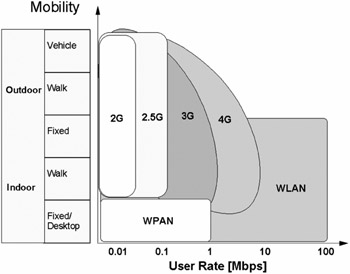1.7 Future of Wireless Technology
1.7 Future of Wireless Technology
The major trend that is already emerging is the migration of mobile networks to fully IP-based networks. The next generation of wireless systems, 4G systems, will use new spectrum and emerging wireless air interfaces that will provide a very high bandwidth of 10+ Mbps. It will be entirely IP-based and use packet-switching technology. It is expected that 4G systems will increase usage of wireless spectrum. According to Cooper's law, on average, the number of channels has doubled every 30 months since 1985.
Figure 1.17 shows the user mobility and data rates for different generations of wireless systems, and for wireless PANs and LANs. The 3G and later 4G systems will provide multimedia services to users everywhere, while WLANs provide broadband services in hot spots, and WPANs connect personal devices together at very short distances.

Figure 1.17: User mobility and data rates for wireless PANs and wireless LANs. (Adapted from Pahlavan, K. and Krishnamurthy, P., Principles of Wireless Networks, Prentice Hall, Englewood Cliffs, NJ, 2002.)
Spread spectrum technology is presently used in 3G systems; however, there are already research experiments with Multicarrier Modulation (MCM), which is a step further from spread spectrum. MCM transmits simultaneously at many frequencies.
New types of smart antennas are currently under development. Most current antennas are omnidirectional, which means that they transmit in all directions with similar intensity. New directional antennas transmit primarily in one direction, while adaptive antennas vary direction in order to maximize performance.
New generations of software radios will dynamically adapt to wireless technology. They apply digital signal processors, so they can update the software with new versions of transmission techniques.
The transition from circuit-switched to packet-switched networks provides increased efficiency of the network and higher overall throughput. However, packet-switched networks operate on a best-effort basis, and therefore, cannot guarantee the service (specifically when the load is high). This will require the development of new QoS (quality of service) approaches to handle various network scenarios.
New wireless multimedia applications will require new solutions related to error resilience, network access, adaptive decoding, and negotiable QoS.
Error resilience solutions should enable delivery of rich digital media over wireless networks that have high error rates and low and varying transmission speeds. Network access techniques should provide the delivery of rich media without adversely affecting the delivery of voice and data services. Innovative adaptive decoding techniques should optimize rich media for wireless devices with limited processing power, limited battery life, and varying display sizes. New negotiable QoS algorithms should be developed for IP multimedia sessions, as well as for individual media components.
EAN: 2147483647
Pages: 239